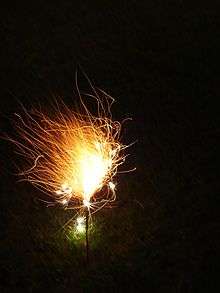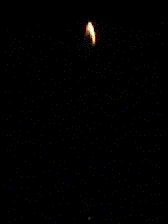Sparkler
A sparkler is a type of hand-held firework that burns slowly while emitting colored flames, sparks, and other effects.
.jpg)


In the United Kingdom, a sparkler is often used by children at bonfire and fireworks displays on Guy Fawkes Night, the fifth of November,[1] and in the United States on Independence Day.[2] They are called Phool Jhadi in India and are popular during the Diwali festival.[3]
Composition
Sparklers are generally formed around a thin non-combustible metallic wire, about 8-12 inches long, that has been dipped in a thick batter of slow-burning pyrotechnic composition and allowed to dry. The combustible coating contains these components, one or more of each category:[4]
- Metallic fuel, mandatory to make sparks; size of particles influences appearance of the sparks
- Additional fuel, optional, modifying the burning speed
- Oxidizer, mandatory
- Potassium nitrate
- Barium nitrate
- Strontium nitrate
- Potassium perchlorate, more powerful but potentially explosive
- Ammonium perchlorate[5]
- Optional pyrotechnic colorants, for colored flames
- chlorides and nitrates of metals, e.g. barium, strontium, or copper
- Combustible binder, holding the composition together
The colored spot on the top of each rod indicates the color of the sparkles emitted when ignited.
A more modern type of sparkler, known as the "Morning Glory", consists of a long, thin paper tube filled with composition and attached to a wooden rod using brightly colored tissue paper and ribbon. Several different compositions can be packed into a single tube, resulting in a sparkler that changes color.
Safety issues
A 2009 report from the National Council on Fireworks Safety indicated that sparklers are responsible for 16 percent of legal firework-related injuries in the United States.[6] The U.S. Consumer Product Safety Commission's statistics from the Fourth of July festivities in 2003 indicate that sparklers were involved in a majority (57%) of fireworks injuries sustained by children under five years of age.[7]
Subsequent reports from the U.S. Consumer Product Safety Commission about "Fireworks-Related Deaths, Emergency Department-Treated Injuries, and Enforcement Activities" indicate:
| Year | Estimated Injuries | % Estimated Sparklers-Related Injuries on all Fireworks-Related Injuries | % Estimated Sparklers-Related Injuries for children under 5 years old |
|---|---|---|---|
| 2011[8] | 1100 | 17% | 36% |
| 2012[9] | 600 | 12% | 30% |
| 2013[10] | 2300 | 31% | 79% |
| 2014[11] | 1400 | 19% | 61% |
The devices burn at a high temperature (as hot as 1000°C to 1600°C, or 1800°F to 3000°F), depending on the fuel and oxidizer used, more than sufficient to cause severe skin burns or ignite clothing.[12] Safety experts recommend that adults ensure children who handle sparklers are properly warned, supervised and wearing non-flammable clothing. As with all fireworks, sparklers are also capable of accidentally initiating wildfires. This is especially true in drier areas; in Australia, for instance, sparkler-related bushfire accidents have led to their banning at public outdoor events during summer like Australia Day celebrations.
Sparkler bombs are constructed by binding together as many as 300 sparklers with tape, leaving one extended to use as a fuse. In 2008, three deaths were attributed to the devices,[13] which can be ignited accidentally by heat or friction. Because they usually contain more than 50 milligrams of the same explosive powder found in firecrackers, they are illegal under U.S. Bureau of Alcohol, Tobacco, Firearms and Explosives (ATF) regulations.[13]
In art and popular culture

An art group, monochrom, was planning to light 10,000 bound sparklers which it described as "symbolic liberation" to reflect that sparklers are generally used in monotheistic traditions.[14] A large group from Toronto, Ontario, Canada also held an event displaying 10,000 sparklers to symbolize brightness, intensity, warmth and creativity.[15] In 1999 the two artists Tobias Kipp and Timo Pitkämö developed a technique of drawing portraits with burning sparklers on paper, which they called pyrografie. Since then the two artists have drawn more than 20,000 pyroportraits.[16]
See also
- Consumer fireworks
- Senko hanabi, the sparklers in Japan.
References
- "10 safety tips for Guy Fawkes". 5 November 2013. Retrieved 11 August 2014.
- "Fireworks Information Center". United States Condumer Product Safety Commission. Retrieved 11 August 2014.
- "Sparklers for Diwali celebrations". 27 October 2013. Retrieved 11 August 2014.
- "Sparkler compositions". Pyrocreations.com. Archived from the original on 2005-02-13. Retrieved 2016-12-25.
- https://patents.google.com/patent/US3862865A/en
- "Sparklers 16 percent of fireworks harm". United Press International. June 22, 2009.
- "The Dangers of Fireworks" (PDF). Topical Fire Research Series. U.S. Fire Administration/National Fire Data Center. 5 (4). June 2005. Archived from the original (PDF) on 2010-12-07. Retrieved 2011-06-28.
- "Fireworks-Related Deaths, Emergency Department-Treated Injuries, and Enforcement Activities During 2011", U.S. Consumer Product Safety Commission, June 2012.
- "Fireworks-Related Deaths, Emergency Department-Treated Injuries, and Enforcement Activities During 2012, U.S. Consumer Product Safety Commission, June 2013.
- "Fireworks-Related Deaths, Emergency Department-Treated Injuries, and Enforcement Activities During 2013", U.S. Consumer Product Safety Commission, June 2014
- "Fireworks-Related Deaths, Emergency Department-Treated Injuries, and Enforcement Activities During 2014", U.S. Consumer Product Safety Commission, June 2015
- "Sparklers Can Burn at 2,000 Degrees Fahrenheit" (PDF). United States Consumer Product Safety Commission. Retrieved 11 August 2014.
- 'Sparkler Bombs' Mar Celebrations, Wall Street Journal
- Free Bariumnitrate Archived February 27, 2007, at the Wayback Machine
- http://ReinventWinter.net Reinventwinter.net
- Pyrografie